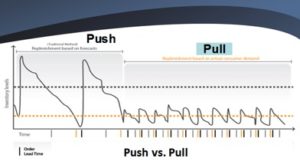Lean Thinking in Distribution for Independent Distributors: The Problem with Traditional Inventory Management in Wholesale Distribution, Part 3
Guest Blog by NetPlus Alliance Service Supplier, Howard Coleman, MCA Associates
…it’s really all about the flow!
…and all about return on investment!
In the illustration above, doesn’t it look like an aberration of the normal curve? It represents a large number of SKU’s that have too little inventory while still another large number of SKU’s have too much inventory. The smallest number of SKU’s appear to be in a more “optimal zone.” How does your inventory compare to this illustration?
You might be asking, “Is this inventory condition a real one?” I can tell you from my own 30 years of experience, and from various surveys I’ve reviewed, that it is a common experience. Some surveys I’ve seen indicate that nearly 90% of the respondents reported that their inventory is represented, to a large degree, by the “Inventory Distribution Frequency” illustration, above.
So What Can You Do Now?
What will it take to break down this constraint, this barrier, and protect and promote the flow of product and information?
Recognize system variability! Anyone in inventory and supply chain management knows that they are constantly waging a battle against variability. It’s an erosive conflict that has gone on literally for decades and truly is the number one enemy of flow. Flow is impeded by the “accumulation and amplification” of variability and ultimately gets passed up to and through procurement and then through the inventory replenishment of distribution centers and stocking branches.
Variability impacts how they interact with one another in terms of timely and adequate (the right amount) inventory replenishment. Stock-outs may increase, replenishment lead times may increase. A lot of time is spent trying to pull all the right levers to correct an immediate problem, though you may not really understand the cause at all.
The Answer?
First of all, the answer is not to guess better or to respond to some corporate mandate to “eliminate variability”! Wholesale distributors have tried various approaches for years, and may have even spent a lot of time and money on it too…and most likely failed to reach their goals. The key is to recognize that variability exists and contain it by “exploiting the constraint.”
Here are some key points to focus on, keep in mind, and try to think differently about:
Variance is inherent in forcasting and therefore is a "constraint" in any forecasting methodology. So, why not exploit the constraint?
Why, if you are a multi-location wholesale distributor (multiple branches), is your forecasting challenge more severe? "What, when and how much" are critical to branch replenishment and service levels.
Why are "inventory drivers" such as lead time, safety stock, and order quantity key focus areas where you can apply "lean thinking" and "root-cause analysis"?
Why should you question those Economic Order Quantity (EQQ) formulas you most likely are using?
How do the inventory drivers impact the "frequency of replenishment" and modulate the "flow"?
Why is flow actually enhanced by fostering a "continuous flow" of product?
The difference between “Push vs Pull” and “exploiting the constraints” will be explained in Part 4. Stay Tuned!



